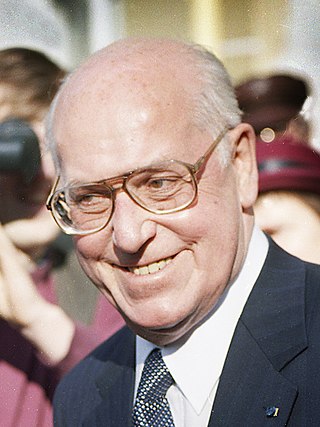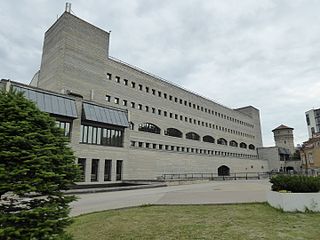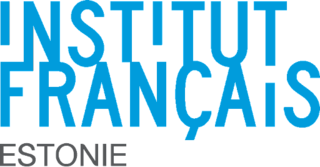
Tallinn Airport or Lennart Meri Tallinn Airport is the largest airport in Estonia, which serves as the secondary hub for AirBaltic and the cargo airline Airest. It was also the home base of the now defunct national airline Estonian Air. Tallinn Airport is open to both domestic and international flights. It is located 2.7 nautical miles southeast of the centre of Tallinn on the eastern shore of Lake Ülemiste. It was formerly known as Ülemiste Airport.

The Singing Revolution was a series of events from 1987 to 1991 that led to the restoration of independence of the three Soviet-occupied Baltic countries of Estonia, Latvia, and Lithuania at the end of the Cold War. The term was coined by an Estonian activist and artist, Heinz Valk, in an article published a week after the 10–11 June 1988 spontaneous mass evening singing demonstrations at the Tallinn Song Festival Grounds.

Lennart Georg Meri was an Estonian writer, film director and statesman. He was the country's foreign minister in 1990–1992 and President of Estonia in 1992–2001.
Tallinn University is a public research university in Estonia. Located in the centre of Tallinn, the capital city of Estonia, Tallinn University is one of the three largest institutions of higher education in the country. Both QS World University and Times Higher Education rankings place it among the top 1000 universities in the world.
Soviet deportations from Estonia were a series of mass deportations in 1941 and 1945–1951 carried out by the Stalinist regime of the former USSR from then Soviet-occupied Estonia. The two largest waves of deportations occurred in June 1941 and March 1949 simultaneously in all three occupied Baltic countries: Estonia, Latvia, and Lithuania. The deportations targeted primarily women, children and the elderly, calling them 'anti-Soviet elements'. In addition, there were Soviet deportations from Estonia based on the victims' ethnicity and religion. Ethnic Estonians who had been residing in Soviet Russia had already been subjected to deportation since 1935.

The National Library of Estonia is a national public institution in Estonia, which operates pursuant to the National Library of Estonia Act. It was established as the parliamentary library of Estonia on December 21, 1918.

The following outline is provided as an overview of and topical guide to Estonia:

FILI – Finnish Literature Exchange is the organisation dedicated to promoting Finnish literature abroad. Its core activity is bringing literature from Finland to the world. FILI was established in 1977 as a subdivision of the Finnish Literature Society (SKS). FILI is also part of the TAIVE network of Finnish arts information organisations, taking an active role in promoting Finnish literature abroad and participating in international projects. FILI has been involved in setting up two international literature networks: we are currently part of the NordLit network alongside our fellow organisations in the Nordic countries, and isa member of the Literature Across Frontiers network as well.

The Hellenic Republic recognised the Republic of Estonia on May 19, 1922. Greece never recognised the Soviet annexation of Estonia. Both countries re-established diplomatic relations on October 2, 1991. In April 1997, Estonia has established an embassy in Athens. The Greek embassy in Tallinn opened in January 2005. Estonia has also 3 honorary consulates in Patras, Piraeus and Thessaloniki. Both countries are full members of the European Union and NATO.

The Balassi Institute is a worldwide non-profit cultural organization funded by the Ministry of Foreign Affairs (Külügyminisztérium) of Hungary. The institute spreads and promotes Hungarian language and culture abroad, and plays a key role in developing and attaining Hungary's objectives in the area of cultural diplomacy. As an organizational hub, it coordinates and directs all activities provided by Hungarian institutes abroad.
It is named after the Hungarian Renaissance lyric poet Bálint Balassi.

Estonia–India relations refers to the bilateral diplomatic relations between Estonia and India. India first recognised Estonia on 22 September 1921 when the former had just acquired membership in the League of Nations. India re-recognised Estonia on 9 September 1991 and diplomatic relations were established on 2 December of the same year in Helsinki. Estonia is represented in India by its embassy in New Delhi and its honorary consulate in Mumbai. India is represented in Estonia through its embassy in Helsinki (Finland) and through an honorary consulate in Tallinn.

The Finnish Cultural and Academic Institutes is a group of 17 independent, non-profit organisations around the world. The institutes advance and support international mobility, visibility and collaboration of Finnish professionals in the arts, culture and research.

The Istituto Italiano di Cultura, the Italian Cultural Institute in English, is a worldwide non-profit organization created by the Italian government. It promotes Italian culture and is involved in the teaching of the Italian language. The creation of the institute was in response to the desire for a deeper understanding of Italian culture throughout many continents. By organising cultural activities it supports the work carried out by the Italian Embassies and Consulates. There are 85 Italian Cultural Institutes throughout major cities around the world.

Estonia, officially the Republic of Estonia, is a country by the Baltic Sea in Europe. It is bordered to the north by the Gulf of Finland across from Finland, to the west by the sea across from Sweden, to the south by Latvia, and to the east by Lake Peipsi and Russia. The territory of Estonia consists of the mainland, the larger islands of Saaremaa and Hiiumaa, and over 2,300 other islands and islets on the eastern coast of the Baltic Sea, covering a total area of 45,335 square kilometres (17,504 sq mi). The capital city Tallinn and Tartu are the two largest urban areas of the country. The Estonian language is the indigenous and the official language of Estonia; it is the first language of the majority of its population, as well as the world's second-most spoken Finnic language.

Eerik-Niiles Kross is an Estonian politician, diplomat, former chief of intelligence and entrepreneur. He is a member of parliament (Riigikogu). During the 1980s, Kross was a prominent figure in the anti-Soviet non-violent resistance movement in Soviet Estonia. After re-independence, in 1991, he joined Estonia's Foreign Ministry. He served as the head of intelligence from 1995 to 2000; and as national security advisor to former President Lennart Meri in 2000 and 2001.

Ülemiste City is a business park in Tallinn, Estonia, on the territory of the former factory complex Dvigatel in Ülemiste neighbourhood. It is situated between Lennart Meri Tallinn Airport, shopping centre Ülemiste Keskus and the Ülemiste railway station, forming the core of the Ülemiste subdistrict.

Alisa Jakobi is an Estonian artist, actress and graphic designer.

Ruth Alas was an Estonian management scientist. She was the head of the Department of Management of the Estonian Business School until her death. Alas wrote more than 100 articles and 23 textbooks in topics relating to management and business.

The French Institute of Estonia was founded in 1992 in Tallinn to promote cultural, scientific, academic, and language cooperation between France and Estonia.

Kulle Raig is an Estonian journalist, writer, and cultural figure.

















